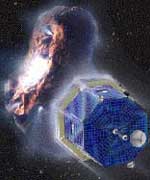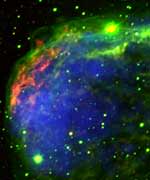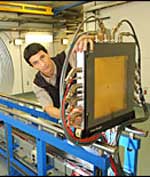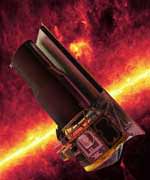
Image credit: NASA
NASA investigators have come up with four possible reasons why the Comet Nucleus Tour (CONTOUR) mission failed in August 2002. The mission launched in July 2002, and was supposed to visit at least two comets and study their icy nuclei, but something went wrong that caused the spacecraft to disappear from ground tracking stations. The most probably cause of the failure was a structural failure of the spacecraft while its solid rocket motor was firing, but the investigators are also considering a collision with debris, a catastrophic failure of the rocket motor, and loss of the spacecraft?s control systems.
NASA’s Comet Nucleus Tour (CONTOUR) Mishap Investigation Board (MIB) identified four possible causes for the failure of the comet-rendezvous mission launched in July 2002. The Board concluded the probable proximate cause for this accident was structural failure of the spacecraft due to plume heating during the embedded solid-rocket motor burn.
However, the lack of telemetry and observational data, immediately prior to and during the burn, and the lack of recoverable debris, leave open the possibility that one of several other problems could have led to the accident. The alternate possible causes are catastrophic failure of the solid rocket motor; collision with space debris or meteoroids; and loss of dynamic control of the spacecraft.
NASA was not able to re-establish contact with the spacecraft on August 15, 2002, following a propulsive maneuver involving the solid rocket motor. On August 22, 2002, the Associate Administrator for Space Science established the NASA CONTOUR Mishap Investigation Board with Theron Bradley Jr., NASA Chief Engineer, as chair. The purpose of the Board was to examine the processes, data and actions surrounding the events of August 15; to search for proximate and root causes; and develop recommendations that may be applicable to future missions.
Based on various facts and data, the MIB concluded the alternate possible causes were less likely than the identified proximate cause. Nonetheless, in the spirit of constructively improving future mission reliability, the Board drew conclusions, identified lessons learned, and made recommendations based on the broader range of possible causes, according to Bradley.
Launched on July 3, 2002, CONTOUR was intended to encounter at least two comets and perform a variety of investigations and analyses of the comet material. It remained in Earth orbit until August 15, 2002, when an integral Alliant Techsystems STAR? 30BP solid rocket motor was fired to leave orbit and begin the transit to the comet Encke.
CONTOUR was programmed to re-establish telemetry contact with the ground following the burn, however, no signal was received. The mission design did not provide for telemetry coverage during the solid rocket motor burn and no provision was made to optically observe the burn.
Active attempts to contact CONTOUR were unsuccessful. On August 16, 2002, limited ground observations identified what appeared to be three separate objects on slightly divergent trajectories near, but behind, CONTOUR’s expected position. Further attempts to contact CONTOUR were made through December 20, 2002, when NASA and Johns Hopkins University/Applied Physics Laboratory (APL), Laurel, Md., concluded the spacecraft was lost. The project manager at APL oversaw the technical implementation of the project and was responsible for the design, development, test and mission operations.
The MIB established Root Causes and Observations contributing to the failure, and recommendations for each in the Report.
“NASA will apply the lessons from CONTOUR to future missions,” Bradley said. He stated the report represented a lot of tough detective work by the many individuals and organizations involved in the investigation. “The lack of data meant the investigators could leave no stone unturned in their search for possible causes,” he said.
Original Source: NASA News Release





